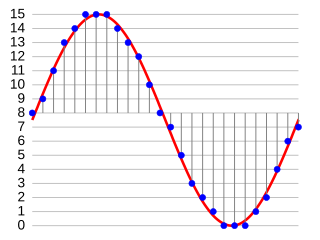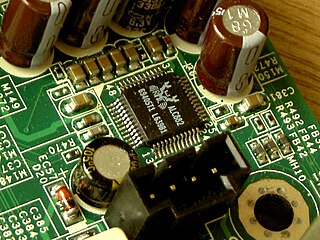RealAudio, also spelled Real Audio, is a proprietary audio format developed by RealNetworks and first released in April 1995. It uses a variety of audio codecs, ranging from low-bitrate formats that can be used over dialup modems, to high-fidelity formats for music. It can be used as a streaming audio format, that is played at the same time as it is downloaded.
MPEG-4 Part 3 or MPEG-4 Audio is the third part of the ISO/IEC MPEG-4 international standard developed by Moving Picture Experts Group. It specifies audio coding methods. The first version of ISO/IEC 14496-3 was published in 1999.
The Enhanced Versatile Disc (EVD) is an optical-medium-based digital audio/video format, developed by Beijing E-World, as a rival to the DVD to avoid the high royalty costs associated with the DVD format. Its development was supported by the Chinese government. While it was intended to replace the DVD standard in China by 2008, the format had failed to gain traction and ultimately faded into obsolescence.
On2 TrueMotion VP6 is a proprietary lossy video compression format and video codec. It is an incarnation of the TrueMotion video codec, a series of video codecs developed by On2 Technologies. This codec is commonly used by Adobe Flash, Flash Video, and JavaFX media files.
OpenMAX, often shortened as "OMX", is a non-proprietary and royalty-free cross-platform set of C-language programming interfaces. It provides abstractions for routines that are especially useful for processing of audio, video, and still images. It is intended for low power and embedded system devices that need to efficiently process large amounts of multimedia data in predictable ways, such as video codecs, graphics libraries, and other functions for video, image, audio, voice and speech.

G.722.1 is a licensed royalty-free ITU-T standard audio codec providing high quality, moderate bit rate wideband (50 Hz – 7 kHz audio bandwidth, 16 ksps audio coding. It is a partial implementation of Siren 7 audio coding format developed by PictureTel Corp.. Its official name is Low-complexity coding at 24 and 32 kbit/s for hands-free operation in systems with low frame loss. It uses a modified discrete cosine transform audio data compression algorithm.

On2 Technologies, formerly known as The Duck Corporation, was a small publicly traded company, founded in New York City in 1992 and headquartered in Clifton Park, New York, that designed video codec technology. It created a series of video codecs called TrueMotion.

High-Efficiency Advanced Audio Coding (HE-AAC) is an audio coding format for lossy data compression of digital audio defined as an MPEG-4 Audio profile in ISO/IEC 14496–3. It is an extension of Low Complexity AAC (AAC-LC) optimized for low-bitrate applications such as streaming audio. The usage profile HE-AAC v1 uses spectral band replication (SBR) to enhance the modified discrete cosine transform (MDCT) compression efficiency in the frequency domain. The usage profile HE-AAC v2 couples SBR with Parametric Stereo (PS) to further enhance the compression efficiency of stereo signals.

Intel High Definition Audio (IHDA) (also called HD Audio or development codename Azalia) is a specification for the audio sub-system of personal computers. It was released by Intel in 2004 as the successor to their AC'97 PC audio standard.
Blackbird is an integrated internet video platform, video editing software, covering non-linear editing and publishing for broadcast, web and mobile.
The first attempt at producing pre-recorded HDTV media was a scarce Japanese analog MUSE-encoded laser disc which is no longer produced.

MPEG-4 Part 14, or MP4, is a digital multimedia container format most commonly used to store video and audio, but it can also be used to store other data such as subtitles and still images. Like most modern container formats, it allows streaming over the Internet. The only filename extension for MPEG-4 Part 14 files as defined by the specification is .mp4. MPEG-4 Part 14 is a standard specified as a part of MPEG-4.
Audio over IP (AoIP) is the distribution of digital audio across an IP network such as the Internet. It is used increasingly to provide high-quality audio feeds over long distances. The application is also known as audio contribution over IP (ACIP) in reference to the programming contributions made by field reporters and remote events. Audio quality and latency are key issues for contribution links. In the past, these links have made use of ISDN services but these have become increasingly difficult or expensive to obtain.

VP8 is an open and royalty-free video compression format released by On2 Technologies in 2008.
SBC, or low-complexity subband codec, is an audio subband codec specified by the Bluetooth Special Interest Group (SIG) for the Advanced Audio Distribution Profile (A2DP). SBC is a digital audio encoder and decoder used to transfer data to Bluetooth audio output devices like headphones or loudspeakers. It can also be used on the Internet. It was designed with Bluetooth bandwidth limitations and processing power in mind to obtain a reasonably good audio quality at medium bit rates with low computational complexity. As of A2DP version 1.3, the Low Complexity Subband Coding remains the default codec and its implementation is mandatory for devices supporting that profile, but vendors are free to add their own codecs to match their needs.
Audience was an American mobile voice and audio-processing company based in Mountain View, California, and was one of the 34 founding members of The Open Handset Alliance. The company went public in May 2012 on the NASDAQ exchange under the symbol ADNC. They specialized in improving voice clarity and noise suppression for a broad range of consumer products, including cellular phones, mobile devices and PCs. They were bought by Knowles for $130 Million in 3Q15 who changed their name to Knowles Intelligent Audio.

aptX is a family of proprietary audio codec compression algorithms owned by Qualcomm, with a heavy emphasis on wireless audio applications.

Opus is a lossy audio coding format developed by the Xiph.Org Foundation and standardized by the Internet Engineering Task Force, designed to efficiently code speech and general audio in a single format, while remaining low-latency enough for real-time interactive communication and low-complexity enough for low-end embedded processors. Opus replaces both Vorbis and Speex for new applications, and several blind listening tests have ranked it higher-quality than any other standard audio format at any given bitrate until transparency is reached, including MP3, AAC, and HE-AAC.
The Alliance for Open Media (AOMedia) is a non-profit industry consortium headquartered in Wakefield, Massachusetts, and formed to develop open, royalty-free technology for multimedia delivery. It uses the ideas and principles of open web standard development to create video standards that can serve as alternatives to the hitherto dominant standards of the Moving Picture Experts Group (MPEG).